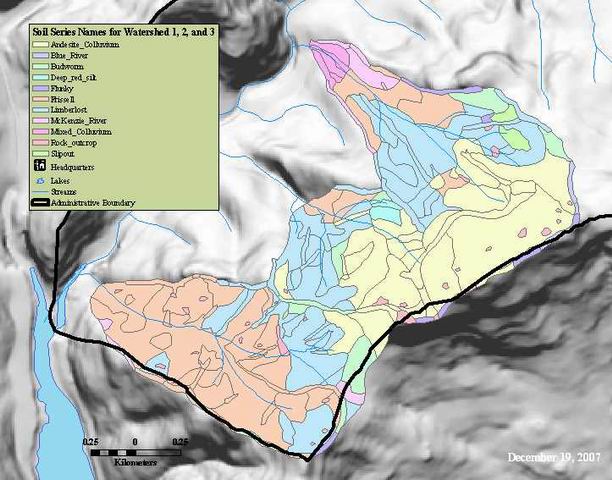Intensive soil survey for the Andrews Watersheds 1, 2 & 3, Andrews Experimental Forest
Shapefile

Tags
history, soils, Blue
River Watershed, Oregon, Willamette Basin, Andrews watershed 1, HJ Andrews Experimental
Forest
To document the history of soil classification for watersheds 1, 2, and 3, using the field map of small watershed survey completed by CT Dyrness in 1964.
Two soil surveys exist for the Andrews small watersheds. Soils datasets were developed from both surveys to test model sensitivity to variations in soil variables. The 1964 soil survey is the soils dataset used by most researchers at the Andrews. It was completed in 1964 by a USGS soil survey team andwas available through the Andrews GIS data archive (FSDB). The 1964 survey includes map units of soil series, percent slope, and Iandform (USDA, 1964). This survey was largely based on aerial photo interpretation.
Additionally, an intensive soil survey was completed for the Andrews WS 1, 2 & 3 in the 1960's in conjunction with the beginning of the small watershed experiments (Dyrness, 1969). In order to create a dataset from the small watershed survey, the soil survey field map (Dymess et al., unpublished) was digitized using Arclnfo 7.0.4 (ESRI,1996). The small watershed survey includes map units of soil series, soil series phase (based on rock fragment), percent slope, and landform. This survey was based on soil profile and Iandform analysis. Soil series and soil phase profile summaries (Rothacher et al., 1967 & Dyrness, 1969) were used to develop the soil depth, percent rock fragment and texture percentages needed for the modeling datasets. The soil attributes were added to the soil survey maps in Arclnfo 7.0.4 (ESRI, 1996) and each attribute layer was converted to a 30m grid using ArcGrid 7.0.4 (ESRI, 1996) for use in the modeling effort/
There are no credits for this item.
While substantial efforts are made to ensure the accuracy of data and documentation, complete accuracy of data sets cannot be guaranteed. All data are made available "as is". The Andrews LTER shall not be liable for damages resulting from any use or misinterpretation of data sets.
Extent
West -122.258898 East -122.224566 North 44.219904 South 44.198715
Maximum (zoomed in) 1:5,000 Minimum (zoomed out) 1:150,000,000